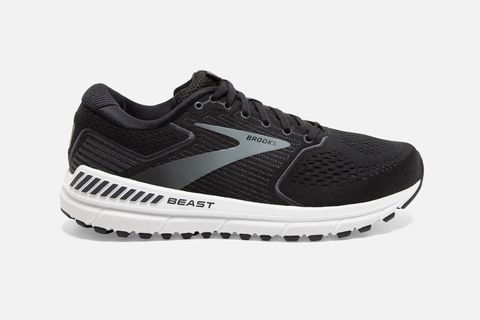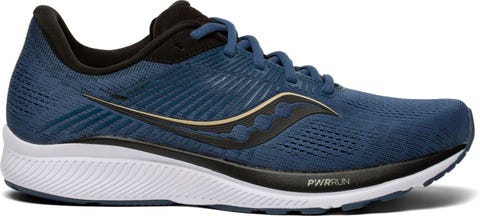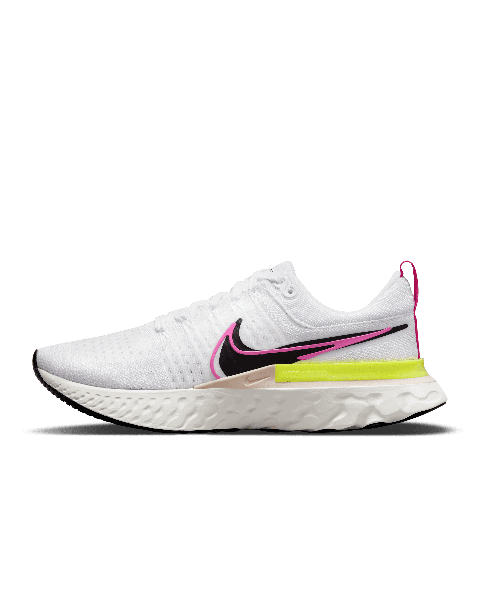If you’re a runner with flat feet, you likely know all too well that finding the right sneakers for a jog in the park, ain’t exactly, well, a walk in the park.
Thankfully, with a little research and guidance (and in many cases, professional counsel from a podiatrist), you can find the right sneakers to support this condition.
What Does It Mean to Have Flat Feet?
“Flat feet is a generic term for people who have feet whose arches collapse or are dropping. It seems like this is a silly term, but the impact of flat feet may have significant consequences on the human body especially on runners and athletes,” says foot and ankle surgeon/podiatrist Mark J. Mendeszoon, FACFAS, FACPM, a partner at Precision Orthopaedic Specialties Inc in Chardon, Ohio and the owner of Achilles Running Shop in Willoughby, Ohio and Erie, Pennsylvania. He notes that the technical term for the condition is pes planovalgus deformity.
Whatever you call it, this condition entails a person losing their shock absorption ability in their feet, says Mendeszoon, and over time they will start to compensate elsewhere. “Compensation will include excessive stress and strain on different muscles, tendons, and joints. And in time, degeneration of tendons, muscles, and joints may occur due to the constant impact and applied stresses applied to the body via running.”
As Mendeszoon shares, the average person will place approximately eight times their body weight running 1,500 steps to complete one mile. That can add up to several million pounds of pressure on the lower extremities in the course of one day, he says. “Due to compensation, runners can develop overuse conditions on their feet, ankles, knees, thighs, hips, and even lower back,” continues Mendeszoon, adding that conditions such as plantar fasciitis, posterior to go tendinitis, shin splint, chondromalacia, patellofemoral stress syndrome, iliotibial band syndrome and even herniated disc can develop due to flat feet.
It’s worth noting that flat feet are caused largely by genetic factors, although “certain pathologies like tibialis posterior dysfunction can [also] decrease the height of the arch (making it appear more flat),” says Blake Dircksen, P.T., D.P.T., C.S.C.S., a physical therapist at Bespoke Treatments in New York City. “So—choose your parents wisely!”
Jokes aside, the condition has more to do with the makeup of your feet than what you do with them—in other words, you can’t run yourself into flat feet. What’s more, guys with flat feet aren’t the only ones who should be selective when they choose their footwear. continues Dircksen. “Pain and injury can happen in the presence of flat and high arches alike, so a thorough understanding of that individual’s unique stressors is critical to getting to the core of any problem—things like their training load, occupation, nutritional status, stress management, sleep, genetics, and more.”
How to Pick Running Shoes With Flat Feet
Yep, you guessed it. See a podiatrist: “A doctor of podiatric medicine can help people minimize overuse conditions by establishing a proper exercise, stretching, and strengthening program,” says Mendeszoon. “In addition, podiatrists can help the athletes by prescribing physical therapy, medication, or even perform surgical intervention on the lower extremities if necessary.”
And if you think you suffer from flat feet, best to address the issue ASAP rather than put off a visit to the foot doc. “Flat feet progressively get worse as we get older. It’s important to recognize this condition when you’re younger and do the appropriate things to slow down the progression of pronation” says Mendeszoon, noting that neglected flat feet may eventually need major reconstructive surgery that can be inclusive of bone fusions in the hind foot. Flat feet may have a genetic component, so proactively taking care of your situation can help future generations know to get their feet checked sooner rather than later.
Beyond booking an appointment with a podiatrist, flat-footed guys can keep these shoe shopping guidelines in mind when they pick out their next pair of running sneakers:
- Make sure the shoes are fitted properly in length and width (many online shoe retailers offer return policies if you’re not buying sneakers in person).
- Aside from gauging a shoe’s feel from wear testing, Dircksen recommends opting for styles that are light, flat, and wide enough to splay your toes out when you run. Don’t get caught up in labels, either. “If a ‘structured’ shoe is comfortable to you, get the structured shoe. If a ‘neutral shoe’ is more comfortable for you, get that one. Try them on, and also try running in them since that’s your goal activity,” Dircksen says.
- Look for sneakers with a comfortable foot bed. Of course, “comfortable” varies by person, so you may have to try on a few pairs to find a foot bed that suits your needs.
- Seek out sneakers with appropriate cushioning and those that provide enough support underneath the medial arch. (Mendeszoon points out that these stability or motion control shoes can reduce the amount of pronation and thus collapsing of the arch; by holding the foot in a more stable position, many of these overuse conditions might be reduced and minimized.)
We can give suggestions for which shoes might be a good idea for guys with flat feet (more on that in just a moment), but at the end of the day, Dircksen believes that the wearer will be the most reliable gauge of what’s best for their feet, their training plan, and their goals. “The best way to select a shoe, without question, is trying on a variety of shoes and picking the one that feels the most comfortable,” he says. “This applies to flat footers and high archers alike.”
And if a guy with flat feet feels pain, they shouldn’t just blame it on their kicks. “Shoes are one piece of the puzzle that can be addressed,” Dircksen says. “However, utilizing a shoe or orthotic as a central piece of the treatment strategy is reductionist and ignores the multiple factors that go into that specific injury (or prevention of that injury).” Speaking of which…
Should People with Flat Feet Wear Orthotics?
A note about orthotics: Generally if someone has a mild form of flat feet, an appropriate running shoe should help alleviate many of their problems, says Mendeszoon.
“If a shoe alone is not sufficient then an over-the-counter insole could be beneficial. If someone’s foot is progressively getting worse and more deformed a custom molded foot orthosis can be individually made to help support and protect the foot,” he says. “It is important that a runner try on running shoes with their custom foot orthoses as this may change the different category of shoe an individual may wear. Remember not everyone needs a custom foot orthosis and not everyone should receive the same type of orthosis. Every condition requires a different type of foot orthosis.”
Again, a qualified podiatrist can help you get the appropriate device, if needed.
What All Runners Should Remember About Running Shoes
Let’s do a general refresher on healthy choices for your feet. These points apply to the general population of runners, too.
- Running shoes have a maximum lifespan of 500 to 600 miles. “If pain and discomfort of a low extremity starts to occur then inspect your shoes and get rid of them and purchase a new pair,” advises Mendeszoon.
- Lace and untie your shoes every time you put them on and off so that the shoes “will fit properly, secure the foot, minimize excess motion or slippage as well as allowing the orthotic to function better by keeping the orthotic (custom foot orthoses) better in place,” says Mendeszoon.
- Focus on flexibility of the lower extremities and strengthening the core to minimize overuse conditions.
The Best Shoes for Guys With Flat Feet
Mendeszoon likes the Beast, is a support shoe from running specialist company Brooks that doesn’t skimp on the cushioning. New for the twentieth edition of the shoes is the brand’s GuideRails tech, which aims to help runners stay in their natural stride. He’s also partial to the company’s Adrenaline line. “Both have tremendous support and cushioning and a very comfortable foot bed,” he says. “Typically these are motion control shoes and do not need insoles or custom orthosis with them. It does take a while to get used to running in the shoes but once a person becomes activated many of their conditions can be improved.”
Asics’ annual workhorse shoe is a solid choice for flat-footed guys due to its lightweight support features. The new 28th iteration has a new gender-specific construction unit beneath the forefoot and heel to cut down on weight and ramp up cushioning and stability along with a dynamic support system.
While not specifically built for people with low or flat arches, Saucony the Guide 14 is a stability running shoe with foam packs for added responsiveness. Add in a ton of support in a relatively light package, and you have a solid option. This sneaker is also available in a wide version.
These Nike kicks include an updated upper from the previous gen that uses Flywire technology for extra breathability. The reliable, comfortable runners also boast serious foam for soft responsive and extended comfort on those 10-milers. Guys with flat feet will likely appreciate the wide shape and extra cushion.
Hoka One One is another brand that’s all about running shoes. The Arahi 6 emphasizes support and stability with a low-profile cushion bed that keeps your foot closer to the ground, and plenty of stability thanks to their J-Frame technology to help “prevent excessive inward roll, or over-pronation, without overcorrecting your gait.” Mendeszoon is a fan of these maximalist shoes with “a tremendous amount of cushioning in addition to support and control,” he says. Wide widths are also available. (He likes the brand’s Gaviota 3 for the same reasons.)
Another great stability running sneaker, the UA HOVR Guardian gets its moniker from its unique ability to help protect and control over-pronation. Some other standout specs: The support elements in the heel and in the midfoot that help to guide the foot into the most efficient foot-strike pattern; responsive HOVR cushioning from heel to forefoot that reduces impact, returns energy, and is designed for distance running; the fact that this high-tech pair of sneakers connects via Bluetooth to MapMyRun, letting you easily track your personal running log.
The Swiss Performance running shoes and apparel brand sure knows how to make a stellar pair of kicks. For flat feet, the Cloudflow is a winner, thanks to its lightweight build coupled with lots of cushioning. They also come in a wide width, which is often recommended for runners with flat feet. For both versions, we also dig that the shoe incorporates On’s Cloudtech, which yields a fast and responsive sensation as you jog, run, or work that fartlek magic. Bonus: the engineered mesh upper provides an ultra-secure fit and keeps foot sweat at bay.
Mendeszoon calls these “a very responsive shoe that provides great transition in the gait cycle,” as well as offering excellent support and stability. Ultra Heel technology keeps the back of your foot securely in place while you run. For those with flat feet who like New Balance and are looking for a walking shoe, Mendeszoon recommends the 928, it’s a “very responsive and supportive shoe that comes in several sizes and widths.” (The widths include narrow, standard, wide, X-Wide, and XX-wide.)
This content is created and maintained by a third party, and imported onto this page to help users provide their email addresses. You may be able to find more information about this and similar content at piano.io












Comments are closed.